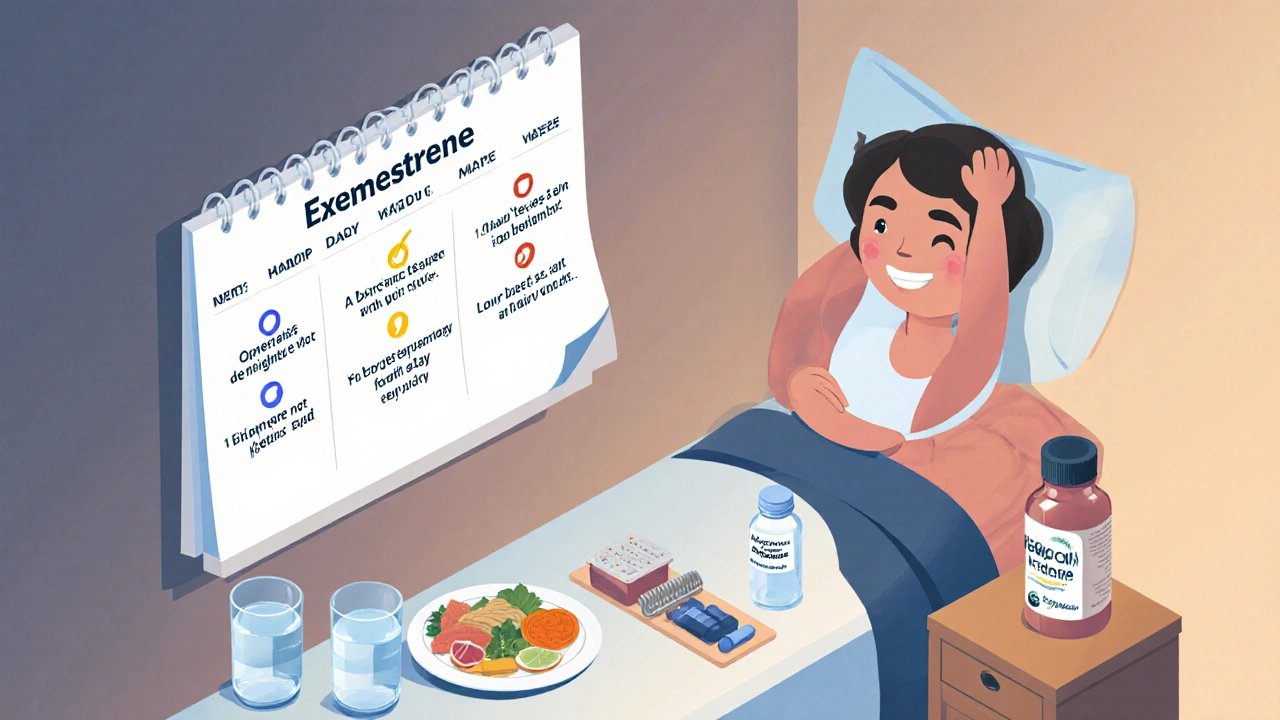Exemestane is an oral aromatase inhibitor used after surgery or radiation to treat hormone‑receptor‑positive breast cancer. If you’ve been prescribed this medication, you’ve probably heard the phrase “blood clot risk” tossed around. What does it really mean, and how can you stay safe? This guide walks you through the science, the numbers, and the practical steps you can take.
How Exemestane Works
Exemestane blocks the enzyme aromatase, which converts androgens into estrogen. Lower estrogen levels starve breast‑cancer cells that rely on the hormone to grow. Unlike some other hormone‑blocking drugs, exemestane is a steroidal inhibitor - it binds irreversibly to aromatase, providing a more sustained effect.
Blood Clots 101
When we talk about blood clots, we usually mean two related conditions:
- Deep vein thrombosis (DVT) - a clot that forms in the deep veins of the leg or pelvis.
- Pulmonary embolism (PE) - a clot that breaks free and travels to the lungs, which can be life‑threatening.
Both are forms of venous thromboembolism (VTE). The body’s clotting system is a delicate balance; too much clotting, and you risk VTE, too little, and you bleed.
What the Data Say About Exemestane and Clots
Large clinical trials (ATAC, I‑EVE, and others) have tracked VTE events in thousands of women on aromatase inhibitors. Here’s a quick snapshot:
| Drug | Study Population | VTE Rate (per 1,000 patient‑years) |
|---|---|---|
| Exemestane | ~7,000 women | 2.1 |
| Anastrozole | ~12,000 women | 2.5 |
| Letrozole | ~6,500 women | 2.8 |
| Placebo/No AI | ~8,000 women | 1.5 |
Notice that exemestane’s numbers sit slightly lower than its non‑steroidal cousins, but the risk is still above the baseline. In plain English, for every 1,000 women taking exemestane for a year, about two may develop a clot.
Who’s Most at Risk?
Risk isn’t uniform. Certain factors tip the scales:
- Age - women over 65 have a higher baseline VTE rate.
- Body mass index (BMI) - obesity increases clot‑forming proteins.
- History of clotting - prior DVT or PE is a red flag.
- Genetic thrombophilia - conditions like Factor V Leiden raise risk.
- Concurrent meds - chemotherapy, hormonal therapy, or certain antibiotics can aggravate clotting.
Understanding your personal profile helps you and your clinician decide whether exemestane’s benefits outweigh the clot risk.
Comparing Aromatase Inhibitors
If you’re weighing options, look beyond just the clot numbers. Here’s a side‑by‑side view of the three main AIs:
| Feature | Exemestane | Anastrozole | Letrozole |
|---|---|---|---|
| Type | Steroidal (irreversible) | Non‑steroidal | Non‑steroidal |
| Typical Dose | 25 mg daily | 1 mg daily | 2.5 mg daily |
| VTE Rate | 2.1/1,000 PY | 2.5/1,000 PY | 2.8/1,000 PY |
| Joint Pain | Medium | Low | Higher |
| Bone Density Impact | Less severe | Moderate | Higher loss |
Exemestane tends to be chosen when doctors want a steroidal approach or when patients experience bone‑density loss on non‑steroidal AIs.

Monitoring While on Exemestane
Regular check‑ups are the backbone of safe therapy:
- Baseline blood work - CBC, fasting lipids, and liver function.
- Baseline imaging if you have a prior clot history - duplex ultrasound or CT pulmonary angiography.
- Quarter‑yearly visits - doctor checks for leg swelling, calf tenderness, or shortness of breath.
- Annual bone‑density scan - especially important for post‑menopausal women.
If any red‑flag symptoms appear (painful, swollen leg; sudden chest pain; rapid breathing), seek medical attention immediately.
Managing the Risk
You can actively lower your clot chances while staying on exemestane:
- Stay mobile - avoid prolonged sitting, get up every hour during long flights or desk work.
- Stay hydrated - dehydration makes blood thicker.
- Maintain a healthy weight - aim for a BMI under 30 if possible.
- Consider aspirin - low‑dose (81 mg) aspirin may be recommended by your doctor if you have moderate risk and no bleeding issues.
- Review other meds - discuss any over‑the‑counter NSAIDs or hormone supplements with your oncologist.
In high‑risk situations, doctors sometimes prescribe a short course of a blood thinner (e.g., apixaban) during the first few months of AI therapy.
Key Takeaways
- Exemestane lowers estrogen, helping prevent breast‑cancer recurrence, but it carries a modest increase in Exemestane blood clot risk.
- The overall VTE rate is about 2 per 1,000 patient‑years-slightly lower than other aromatase inhibitors.
- Age, obesity, previous clot, and genetic factors boost your personal risk.
- Regular monitoring, staying active, and talking to your doctor about aspirin or temporary anticoagulation can keep the risk manageable.
- Choose the AI that fits your overall health profile; exemestane is a solid option for many, especially when bone health is a concern.
Can exemestane cause blood clots?
Yes, clinical trials have shown a slightly higher incidence of venous thromboembolism (VTE) in women taking exemestane compared with placebo. The risk is modest-about 2 cases per 1,000 patient‑years-but it is real and warrants monitoring.
How does the clot risk of exemestane compare to other aromatase inhibitors?
Exemestane’s VTE rate (≈2.1/1,000 PY) is a bit lower than that of anastrozole (≈2.5) and letrozole (≈2.8). The differences are small, and individual patient factors usually drive the final choice.
What symptoms should prompt an immediate doctor visit?
Watch for sudden swelling or pain in one leg, especially the calf, and for chest pain, shortness of breath, or coughing up blood. These could signal a deep vein thrombosis or pulmonary embolism and need urgent evaluation.
Should I take aspirin while on exemestane?
Low‑dose aspirin may be recommended for patients with moderate clot risk and no bleeding disorders. Always discuss with your oncologist before starting any new medication.
Is there a way to test my personal clot risk before starting therapy?
Blood tests for clotting factors (e.g., Factor V Leiden, prothrombin gene mutation) and a thorough personal/family history can help assess risk. Some clinicians also use a D‑dimer test as a baseline.
